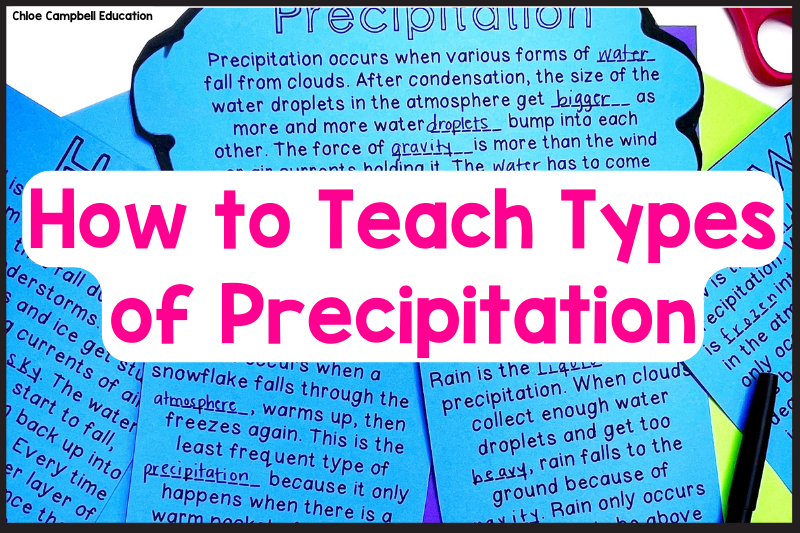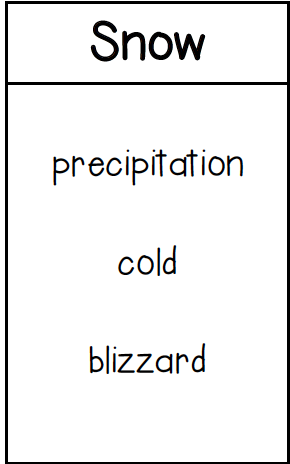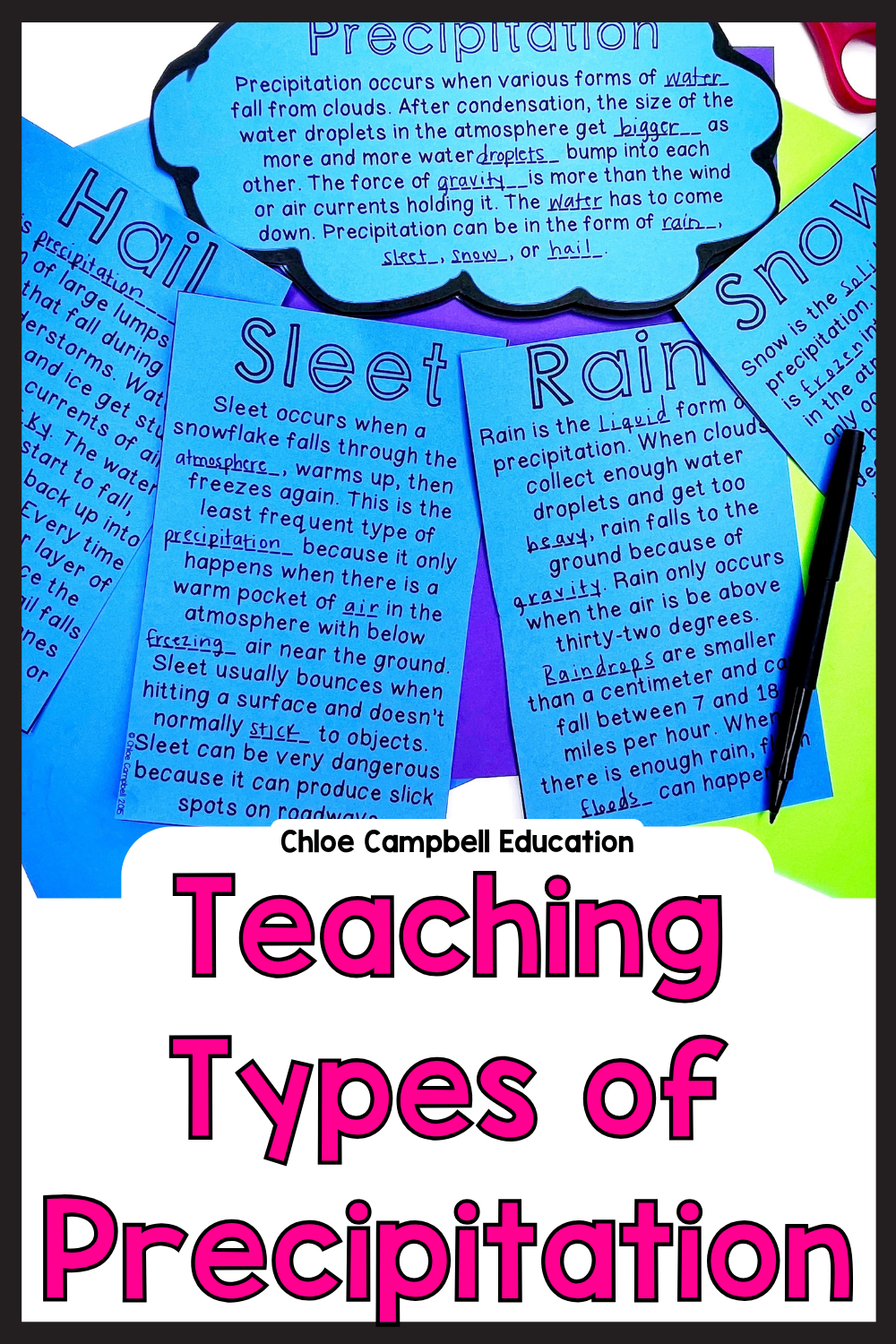Kids are naturally curious, especially about the cool stuff that falls from the sky. Think about it: the excitement of jumping in fresh rain puddles or catching the first snowflakes of winter. In teaching about weather, the lesson on rain, snow, sleet, and hail is a real hit. Over the years, it’s become clear that explaining how these sky gifts form, while also sharing the fun parts, makes learning come alive. In this weather unit, we’ll explore the splashy, snowy, and icy marvels that the sky showers down on us!
This is the first lesson of the weather unit. Below, in the chart, you’ll find an estimated timeline and each of the lessons that will be covered throughout the weather unit.
| Weather Unit Lessons | Estimated Timeline |
| Types of Precipitation | Days 1 – 2 |
| Weather Tools | Day 3 – 6 |
| Climate Zones | Days 7 – 8 |
| Types of Clouds | Days 9 – 10 |
| Review Weather Unit & Assessment | Days 11 – 15 |
Materials You Need:
- Copies of the precipitation mobile
- String or ribbon
- Hole puncher
- Scissors
- Colored Pencils
- Types of Precipitation Foldable Notes
- Vocabulary Game: Don’t Say It
| Essential Questions | – How can you describe the four types of precipitation? – How are the types of precipitation similar and different? – How are the four types of precipitation formed? – How do the conditions in our atmosphere determine the type of precipitation that falls to the ground? |
| Learning Goal & Objective | Students will be able to identify and describe the main types of precipitation (rain, snow, sleet, and hail) and explain how each is formed. |
| Florida Standard | SC.5.E.7.4 Distinguish among the various forms of precipitation (rain, snow, sleet, and hail), making connections to the weather in a particular place and time. |
| Lesson Overview | – Create a Types of Precipitation Mobile (Day 1) – Create a Types of Precipitation Foldable (Day 2) – Vocabulary Game: Don’t Say It (Day 2) |
| Higher Order Thinking Questions | – What motion did you create for rain/snow/sleet/hail? What does it symbolize? – How are rain and snow different? – How are sleet and hail different? – How are sleet and hail similar? – If an area started experiencing more hail than usual, what changes in the atmosphere might be causing this change? – How are snow and hail different? – How does temperature impact the types of precipitation seen in one area? – If you were giving tips for road safety during the winter, what advice would you give for when it’s snowing versus when it’s sleeting? – What is your favorite type of precipitation? Why? |
Day 1: Types of Precipitation Mobile Activity
Use this mobile to teach the four types of precipitation. Open the first 20ish minutes filling in the blanks and discussing each type of precipitation Students will then cut out each part, punch holes, then tie string to create the mobile. On the backside of each sheet is a visual that shows what each type of precipitation looks like when falling from the sky. If time, have students color in the precipitation and the bubble letters.
My favorite part about this mobile is that there are two different options for you and your students! There is a fill-in-the-blank version and one that is already filled in for you.

The filled in version makes it super easy to catch up any students who are absent by using the one that’s already completed. The students still get to make the mobile and learn the information, but it doesn’t take any time away from anyone else to help them. You can also use the completed mobile for any students who have difficulty copying answers from the board. They can still underline and/or highlight key parts, but it will be quicker to review.
Day 2: Types of Precipitation Foldable Notes & Vocabulary Game
Start off class by challenging students to make hand gestures to represent each type of precipitation. Let your students work with a partner to come up with motions to help them remember rain, snow, sleet, and hail.
An example: One year, I had a group of students compare hail to a basketball bouncing between clouds as it gets bigger and bigger. I’ve borrowed that analogy to use with every class since then!
Foldable Notes
It’s now time to make a quick set of foldable notes. The goal is for students to add 3-4 bullet points for each type of precipitation. You can do this three different ways:
- Teach this as a whole group. Go through each type of precipitation and talk about it as a class. Have students give you specific ideas to write inside the foldable notes.
- Allow students to work with a partner and use yesterday’s mobile to add notes to their foldable notes today.
- Have students read this article. Using the non-fiction text, students can then add bullet points to their foldable notes. This gives students more of an opportunity to work independently or with a partner.
Don’t Say It! Game
Once the foldable is complete, it’s time to play a game! It’s called, “Don’t Say It”. We’ll play a longer version of the game later in this unit, but we’ll introduce the game with just the four types of precipitation. The student will get a card with a vocabulary word at the top. The student’s job is to make their teammates guess the word. Here’s the catch: they can’t say any of the listed keywords. This requires students to get creative and think outside of the box.
Using the above picture as an example card, the student’s goal is to make his/her classmates guess the word “snow”. However, the student can’t say precipitation, cold, or blizzard when giving cues about the word. They can use words or motions for this game.
Types of Precipitation Exit Slip Question Ideas:
- How does the temperature of the air at different heights affect whether we see rain, snow, sleet, or hail on the ground?
- List the four main types of precipitation discussed today. Choose one and explain when and how it typically forms.
- What needs to happen in the sky for sleet to fall instead of just snow or rain?
- What’s special about how hail is made compared to rain or snow?
- Why is hail sometimes bigger than other times?
- Why is snow able to stack up, layer upon layer, whereas rain cannot?
Love this lesson?
Get everything for the types precipitation lesson here OR get all the weather activities done for you here!
Save this Science Lesson!
Pin these ideas to your favorite classroom Pinterest board. Then you can come back whenever you need ideas or inspiration!







Leave a Reply